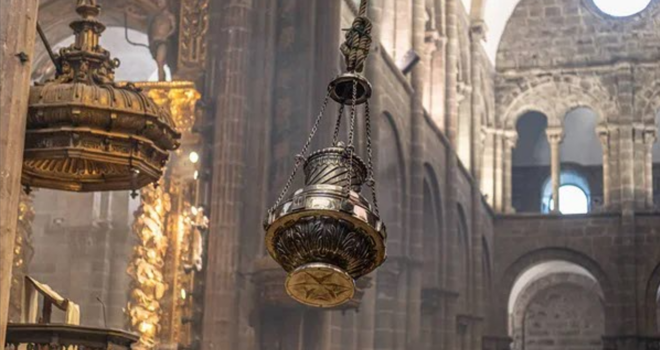It is now rather difficult to deny the fact that young Catholics are flocking in droves to reverent, even traditional, liturgies. Many older Catholics watch confusedly as young people overlook the cultural fads of the seventies and eighties that have long infiltrated much of the Church in the United States. Seeing these fads to be rather sensational and charged with dynamic emotion, it may seem preposterous that young Catholics of this age are instead choosing silence, ordered routine, and what some might perceive to be monotony. Silent adoration is preferred to guitar-guided meditation, Gregorian chant is desired more than Christian rock, and, as is increasingly the case, seeing the priest’s back rather than his face is received with a pious excitement. How is it that a reverent, traditional celebration of Holy Mass is stirring the hearts and minds of young Catholics?
I have grown up in the Catholic education system my entire life. I attended an ordinary K-8 parochial school with “religion” class and school-wide Mass every Wednesday. During my tenure there, my interest in the Catholic faith was slim to nothing. My desire to receive the Sacraments was non-existent, considering that any real knowledge of what the sacraments entailed was never properly conveyed. The school, as do most lukewarm Catholic schools, had good intentions, but the catechetics and liturgy were completely without substance. Now, I understand that this story is almost identical to that of most Catholics who attended Catholic schools in the United States beginning in the late sixties and early seventies, but mine took a graceful turn soon after.
Upon graduation from my parochial school, I had the grace to attend Jesuit High School in Tampa, Florida. It was there that I first encountered reverent liturgy. I was immediately dazzled by the many ways in which reverent liturgy, with a proper understanding of the human person as a body-soul composite, flooded my senses with the seemingly superfluous “smells and bells” in order to lift my soul to God.
Instead of the cheesy piano and Beatles-style music, the organ roared and shook me from within. In lieu of theatrical English lyrics, the boys’ schola sang Gregorian chant in Latin and traditional hymns as if crying out from the heart. Rather than high-fiving students and clapping during the procession, six Jesuits (yes, Jesuits!) approached the altar with reverent expression ready to ascend to the throne of grace to fulfill their priestly office. Fourteen altar boys in almost militaristic formation preceded the priests. Parts of the Mass were sung, and the sermon was preached with fatherly admonition. The list could go on. In being immersed into the reverence and grandeur of this Mass, I finally began to understand what had been lacking all along. For the first time in my life, kneeling in those pews with eyes peeled, I intuitively understood that something much greater than anything in my own little world was occurring before my eyes.
Looking back now, I understand that Our Lord made use of reverence in the liturgy to draw my heart to Himself. It was that experience that led me to crave the sacred more and more in my everyday life. The Lord, through the beauty of the Holy Sacrifice of the Mass offered with reverence and, yes, all of the “externals” so unfortunately thrown away by our Church, woke me up from the boredom of cheap sensationalism and idiosyncratic liturgy.
My story is one among so many, and the stories continue to come to fruition even in the wake of the tragic cancelling of traditional Masses. We must begin to consider that the statistics regarding the connection between reverent, traditional liturgy and authentic belief (lex ordandi, lex credendi) are not the product of merely probable correlation. There seems to be an overwhelmingly visible relation of strong causation, as especially witnessed to by countless Catholic adolescents, young adults, young married couples, young families, and, indeed, young priests.
The youth of the Church is the future of the Church. We take our place amidst countless generations of Catholics who have come before and, God willing, will come after us. Young Catholics desire the stability and timelessness of “lowercase-t” tradition just as much as “capital-t” Tradition. No longer content with practices enculturated by the zeitgeist of the sixties, seventies, and eighties, we seek to pray in the way that the Saints did. Rather than attempting to mold our holy religion to the cultural preferences and conventions of our modern times, we seek the same fountains from which the saints of old drank and were satisfied.
So counter-cultural is reverent liturgy to our modern times that we find ourselves almost coming into sense contact with our removal from space and time during Holy Mass. Our human nature finds itself brought into contact with the nourishment that Our Lord intended for all mankind when our public worship is reverent and traditional. With no longer any need to force our attention and devotion, reverence and tradition lift our minds and hearts to God gently and sweetly.
This youthful “obsession” with reverent, traditional liturgy which we are seeing in the Church today is far from a mere antiquarian phase. The source and summit of the lives of many generations of Catholics will never escape the collective memory of the Mystical Body of Christ, even if it is the child who must remind his parent or grandparent. Reverence and tradition can never be points of Catholic division because Holy Mother Church has unwaveringly guarded them throughout the ages. Young Catholics, through their participation at reverent liturgies, are being reignited in their senses of and desires for the grandeur of God.
Photo by Luca Daddezio on DepositPhotos.










